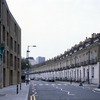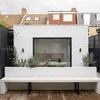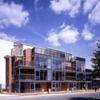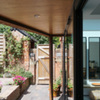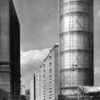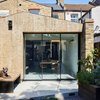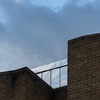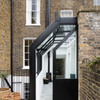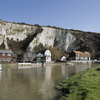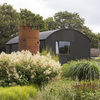The Slot House
Subscribe now to instantly view this image
Subscribe to the Architects’ Journal (AJ) for instant access to the AJ Buildings Library, an online database of nearly 2,000 exemplar buildings in photographs, plans, elevations and details.
Already a subscriber? Sign in
230_slothouse1
The challenge of this project was to tease functional and delightful spaces out of an unpromising opportunity
The plot was a narrow 2.8m wide break in an existing terrace, bounded by flank walls on both sides, that had lain vacant for a number of years. We made a conscious decision to eschew a previous planning consent for a larger 3-storey house in favour of a more appropriate smaller 2-storey 1-bed scheme prioritising quality of space over minimising space standards and maximising value.
To fully exploit the constrained width, avoid loading the neighbouring structures and straddle shared utilities running under the site, the house was constructed using a lightweight steel frame on a piled slab. The steelwork was prefabricated as a series of portal frames that were craned down the alley and site-welded together. Given that every inch in such a narrow space is valuable we chose to fully weld the connections and express the frame internally, even utilising the depth of the steels to maximise the space.
Alongside the painted steel a simple palette of spruce plywood, douglas fir joists, terrazzo and cork flooring enriches the interior. Externally the timber framed walls are clad in handmade pewter glazed tiles. This self-build project had a long gestation and was fitted in around professional and family life. The design and construction were undertaken as time and money allowed. We worked closely with friend and joiner Michael Tye, to lead a small team of local subcontractors and employed specialist fabricators for certain key packages, completing a fair amount of the work ourselves.
The result is a unique and highly crafted home that is a testament to the commitment, effort and support of many people. It highlights the viability, both economically and spatially, of small brownfield sites to provide high quality sustainable development.
Photography by Jim Stephenson
Data
- Begun: Apr 2015
- Completed: May 2019
- Floor area: 64m2
- Sector: Residential
- Total cost: £224,000
- Funding: Private
- Procurement: Self-build with direct employed subcontractors
- CO2 Emissions: 15.39kg/m2/year
- Address: Peckham, London, SE15, United Kingdom
Professional Team 
- Architect: Sandy Rendel Architects
- Client: Sally and Sandy Rendel
- Structural engineer: Structure Workshop
- Planning supervisor: Sandy Rendel Architects
- Main contractor: Michael Tye
Suppliers
- Light fittings: Zangra and Flos
- Ironmongery: d line
- Kitchen worktop: Cavendish Equipment
- Brassware: Hansgrohe
- Sanitaryware : Kaldewei
- Sanitary Ware: Duravit
- Timber flooring: Love Floors
- Cork floors: Siesta Cork Tile Co
- Plastering: Gary Stewart
- Terrazzo: JMGT
- Main construction: Michael Tye Ltd with Sebastian Dyrkacz
- Electrics: R & DP Solutions Ltd
- Plumbing: Thames Heating Ltd
- General builder: John Miller and Mark Farrant
- General builder: Myriad construction Ltd
- Piling : Neil Foundations Systems
- Steel frame manufacturer and welding: Ken Ware Engineers Ltd
- Ground slab: Gebouw Design and Build Ltd
- Kitchen doors and fittings supplier: WTHB design
- Fitted furniture: Studio Onni Aho
- Roofing: Durable Contracts (Roofing) Limited
- Painting and decorating: Marek Horak
- Windows : Luxal
- Front door screen: West Leigh
- Steel staircases: M&M architectural
- Screeding: John Gibb Plastering Ltd
- Air permeability testing: Ecoflow Ventilation Ltd
- Bricklayer: Tom Young
- Corian worktops: Westwood Fabrications
- Tiling: JT Tiling






















